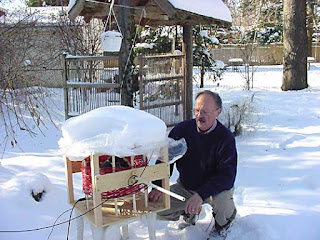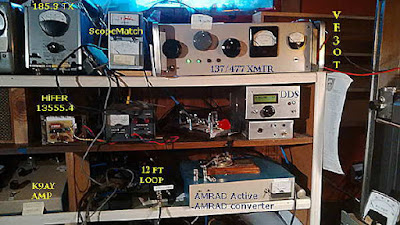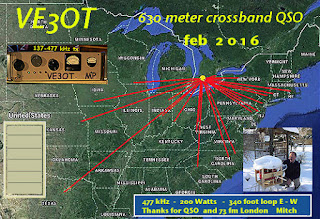Posts Tagged ‘VE3OT’
 The VE3OT 630m Beacon
The VE3OT 630m Beacon

I suspect there are probably a lot of Canadian amateurs still thinking that our new 630m is not very practical for anything other than local two-way contacts.
During the winter 'DX season', this is definitely not the case, as 630m shares many, if not all, of the propagation characteristics found in the lower end of our AM broadcast band. As well, a quick tune through the even lower NDB band on a normal night will reveal dozens of 25-watters, often from over a thousand miles away and with very robust signals.
With no 630m amateur activity yet coming from VE6, VE5 or VE4, it is difficult to get a sense of just how interesting the band could become on these normal nights, or how great it would be on a really good night of propagation. My recent CW contact with the nearest out of province station, VE3OT (Mitch), on a normal night, demonstrates that there is a lot of potential for some really effective two-way work over long distances.
So ... what do signals sound like between here and Ontario? Here is Mitch's CW beacon as heard here on the evening of February 11th, at around 2300 hours local time, using my 10' x 20' loop. I have heard Mitch at even higher levels than this, but his beacon is usually audible here on most undisturbed nights, sometimes as early as 2000 hours local time. His beacon signal runs 200 watts to a 340' circumference loop, from his London, Ontario, suburban backyard.
Even if you are not able to hear Mitch's signal audibly, it should be fairly easy to copy in one of the QRSS CW modes, such as QRSS3 or QRSS10 ... both of which could yield a reasonably quick two-way contact.
Judging from the reliability of the VE3 signal, any activity from the prairie provinces should be even easier to hear. Should any of you in the prairies take up the 630m challenge, I can assure you that you'll be very, very popular out west ... every night!
This blog also provides an opportunity for my initial use of the 'tunestotube' web site. It provides a nice online interface for posting audio files to Youtube, along with an image, or a slideshow. It seemed to work seamlessly and will save me having to link to audio files stored on my own web site, which really eat up what little space I have left.
 Trans-Canada On 630m
Trans-Canada On 630m
 |
| courtesy: http://www.bing.com/mapspreview |
Both Mitch and myself had been alerted to the excellent propagation earlier in the week, when VE3OT's CW beacon had reached S9 levels here for several hours on two consecutive nights ... but any late-night QSO attempts would have to wait until the weekend, when having to get up in the middle of the night would not conflict with Mitch's workweek schedule.
Our first attempt, late on Friday night and 3A.M. for Mitch, found that conditions had deteriorated from midweek's enhanced propagation and the low signal levels, combined with some unseasonal lightning noise, resulted in rescheduling for another shot on Saturday.
Late Saturday night found the band much quieter and propagation much improved, but not as good as it had been earlier in the week ... somehow Murphy always seems to have a hand in pre-planned events, and it's never a helpful one. Mitch's beacon signal was readable here but had a deep ten-minute fade cycle with a short-lived peak before fading out to nothing.
 |
| VE3OT at his loop's loading coil |
 |
| LF / MF station at VE3OT |
For those of you that worked VE3OT during the recent 630m crossband event, Mitch has put together a very special QSL card!
As the solar cycle winds down, the 'good' nights will happen more often, as will the truly 'great' nights. Hopefully there will be more Canadians on the band to take advantage of what lies ahead.
Hopefully the U.S.A. will soon have the band as well, which will really spark nightly activity. What is really needed right now is more Canadian activity, especially in the western provinces, where nightly CW contacts could be readily made. Time to reach for the solder iron! There are several VE7's, and one VE3, waiting and wanting to work you!













